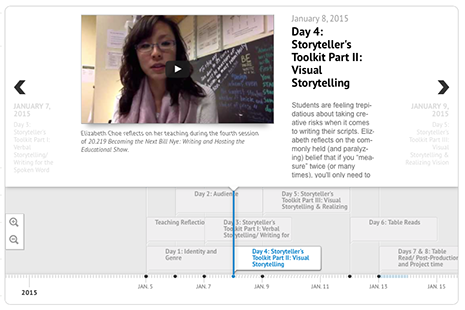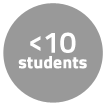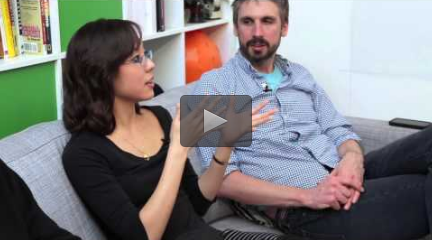Instructor Insights pages are part of the OCW Educator initiative, which seeks to enhance the value of OCW for educators.
Course Overview
This page focuses on the course 20.219 Becoming the Next Bill Nye: Writing and Hosting the Educational Show as it was taught by Elizabeth Choe, Jaime Goldstein, Chris Boebel, George Zaidan, Joshua Gunn, and Natalie Kuldell in IAP 2015.
This course gives students the opportunity to script and on-screen host 5-minute YouTube science, technology, engineering, and/or math-related shows to inspire youth to consider a future in science. Workshop-style lectures, with industry guest speakers, focus on developing students’ basic scripting, hosting, and video production skills in the context of understanding digital media literacy, K-12 education, science advocacy, and engaging a lay audience. Students critically analyze case studies of popular hosts and shows in addition to completing iterative, project-based assignments and peer-critiques, culminating in a 5-minute final episode.
Selected groups have the opportunity to continue optional development of episodes with a professional production crew for the MIT+K12 Videos Science Out Loud series during the final week of IAP ![]() .
.
Learn more here:
Choe, E. "Video Production as a Pathway for Building Identity," SSRN, May 16, 2017.
Course Outcomes
Course Goals for Students
After taking this course, students should be able to:
- Thoughtfully and clearly communicate science, technology, engineering, and/or math topics to a lay audience in an engaging manner - textually, visually, and verbally
- Understand the media production process - from design to premiere of their own videos
- Develop their own hosting and scripting style stemming from an understanding of what makes a successful communicator and guide
- Critically analyze video-based entertainment and education, particularly in the context of K-12 students
- Transfer video production skills to future projects
In the following short videos, Elizabeth Choe and three guest lecturers describe various aspects of how they taught 20.219 Becoming the Next Bill Nye.
- Inspiration for the Course and Intended Learning outcomes
- Teaching as a Team
- Digital Media Literacy
- Assessment and Feedback in Creative Contexts
- Teaching through Workshops
- A Class on Pre-Production
In the following pages, Elizabeth Choe and Jaime Goldstein describe various aspects of how they taught 20.219 Becoming the Next Bill Nye.
- Planning Backwards
- Grading and Feedback in a Course Focused on Creative Work
- Cultivating a Healthy Classroom Culture
 In the following interactive timeline, Elizabeth Choe shares self-recorded confessional-style videos that illustrate a day-by-day account of what what went well and what could have been improved in the teaching of the course.
In the following interactive timeline, Elizabeth Choe shares self-recorded confessional-style videos that illustrate a day-by-day account of what what went well and what could have been improved in the teaching of the course.
20.219 Teaching Reflections Timeline
Curriculum Information
Prerequisites
Instructor permission
Requirements Satisfied
None
Offered
20.219 is a Selected Topics course in Biological Engineering; different offerings feature different topics. This was the first semester that Becoming the Next Bill Nye was offered.
Assessment
The students' grades were based on the following activities:
 25% Class participation
25% Class participation 20% Daily blog/vlog reflections
20% Daily blog/vlog reflections 25% Workshop products
25% Workshop products 30% Final project
30% Final projectClass participation
- Because this was a workshop-based course, and because sessions built upon each other, it was crucial for students to attend every class.
- Meaningful peer feedback was crucial throughout the production process, and students were expected to be involved and engaged in this workshop-based class (discussions, table reads, rough cut annotations, etc.)
› Read More/Read Less
Student Information

Breakdown by Year
The class included undergraduate and graduate students from MIT, along with exchange students from Singapore University of Technology and Design.
Breakdown by Major
Participants came from a variety of schools, departments, and programs including the Sloan School of Management, Naval Architecture, Math, Mechanical Engineering and D-Lab.
Enrollment Cap
24
During this 3-week course, students were expected to spend 20 hours per week, roughly divided as follows:
In Class
- Met 5 times per week for 3 hours per session; 13 sessions total; mandatory attendance.
- Class sessions included lectures and workshops related to the educational video genre and the media production process.
- Several class sessions included opportunities for students to work one-on-one with the teaching staff, which included the instructors, a teaching assistant, and guest lecturers.
Out of Class
Students wrote daily blog/vlog reflections, completed readings, and created iterations of their final project components.
Semester Breakdown
| WEEK | M | T | W | Th | F |
|---|---|---|---|---|---|
| 1 |  |  |  |  |  |
| 2 |  |  |  |  |  |
| 3 |  |  |  |  |  |
| 4 |  |  |  |  |  |
 No classes throughout MIT
No classes throughout MIT Workshop
Workshop Filming and editing final projects
Filming and editing final projects Due date (assignments, blog/vlog)
Due date (assignments, blog/vlog) No class session scheduled
No class session scheduled Guest Speaker
Guest Speaker Screening session
Screening session


 Room 1 of 1
Room 1 of 1 